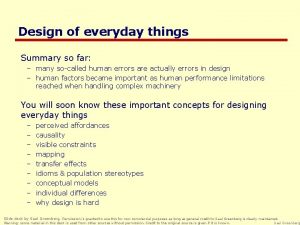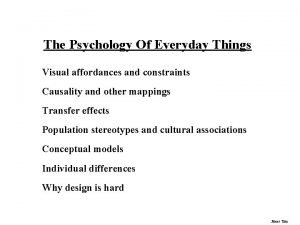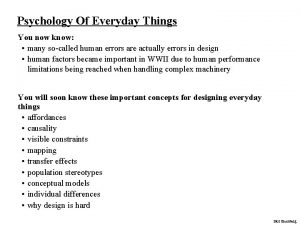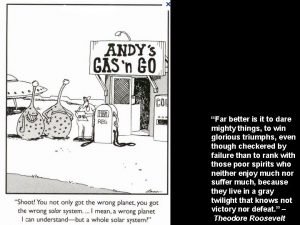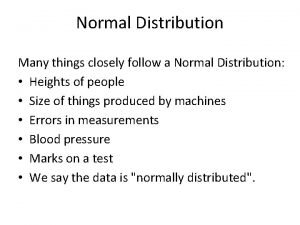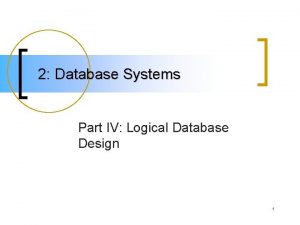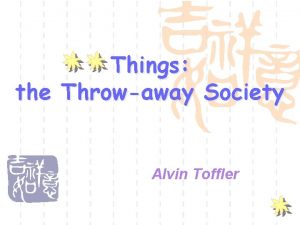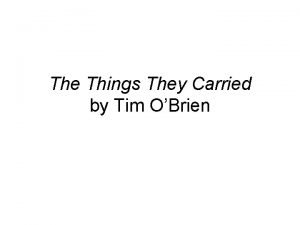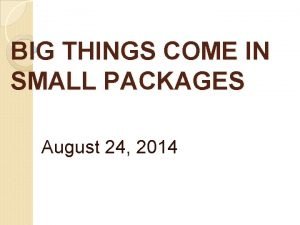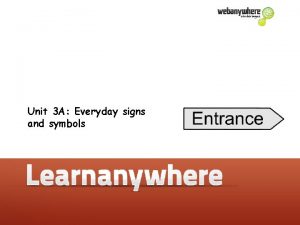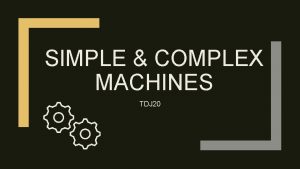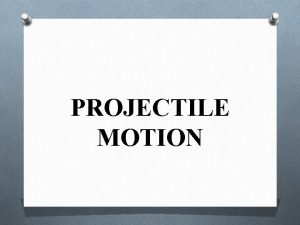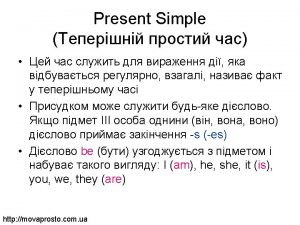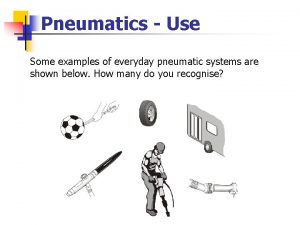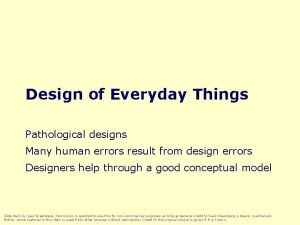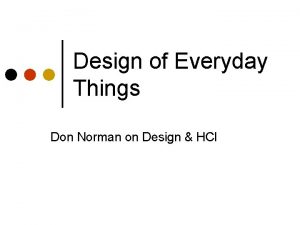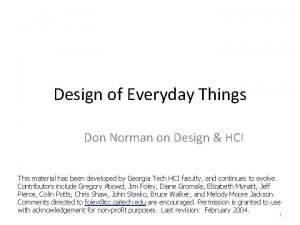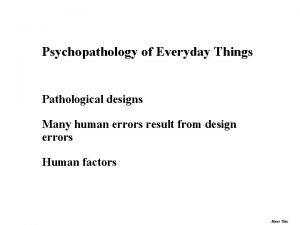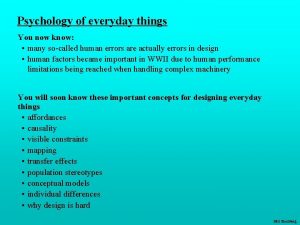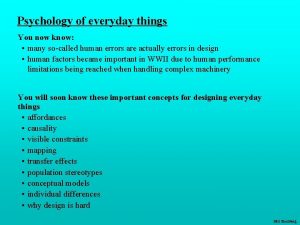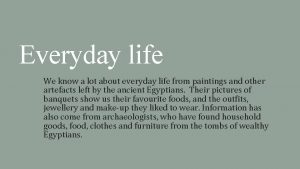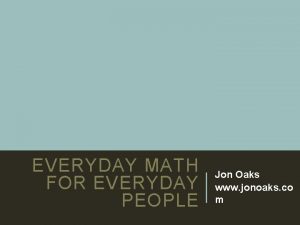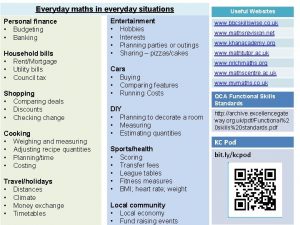Design of everyday things Summary so far many



















































- Slides: 51

Design of everyday things Summary so far: – many so-called human errors are actually errors in design – human factors became important as human performance limitations reached when handling complex machinery You will soon know these important concepts for designing everyday things – – – – – perceived affordances causality visible constraints mapping transfer effects idioms & population stereotypes conceptual models individual differences why design is hard Slide deck by Saul Greenberg. Permission is granted to use this for non-commercial purposes as long as general credit to Saul Greenberg is clearly maintained. Warning: some material in this deck is used from other sources without permission. Credit to the original source is given if it is known. Saul Greenberg

Perceived Affordance The perceived properties of the object that suggest how one could use it chairs are for sitting table for placing things on slots are for inserting handles are for turning knobs are for turning buttons are for pressing switch for toggling Many concepts in this section are adapted from Don Norman’s book: The Design of Everyday Things computer for… Saul Greenberg

Perceived Affordances Product design – perceived affordances: • design invites people to take possible actions – actual affordances: • the actual actionable properties of the product Problems occur when – these are not the same, – people’s perceptions are not what the designer expects In-depth discussion available at www. jnd. org/dn. mss/affordances-and-design. html Saul Greenberg

Perceived Affordances Mirrors for not touching Knobs for turning Handles for lifting Surface for placing transparencies Saul Greenberg

Perceived Affordance Problems Mirrors for not touching people don’t reposition image Knobs for turning Handles for lifting focus or image position? bends frame, focus distorted Surface for placing transparencies which way is up? what about this? Saul Greenberg

Perceived Affordances GUI design – perception only through visuals – designer creates appropriate visual affordances via • familiar idioms • metaphors Saul Greenberg

Perceived Affordances dials for turning sliders for sliding music console for controlling music Saul Greenberg

Perceived Affordance Problems is this equalizer control a toggle or button? button for pressing, but action unknown are these buttons? Saul Greenberg

Perceived Affordance Problems Is this a graphic or a control? IBM Real Phone A button is for pressing, but what does it do? Visual affordances for window controls are missing! text is for editing, but it doesn’t do it. Saul Greenberg

Perceived Affordance Problems IBM Real Phone Saul Greenberg

Perceived Affordance Problems Handles are for lifting, but these are for scrolling! Complex things may need explaining but simple things should not – when simple things need labels & instructions, then design has failed Audio. Rack 32, a multimedia applicaiton Saul Greenberg

Visible Constraints Limitations of the actions possible perceived from object’s appearance – provides people with a range of usage possibilities Push or pull? Which side? Can only push, side to push clearly visible Saul Greenberg

Which side do you use for cutting? Photograph courtesy of www. baddesigns. com Saul Greenberg

Visible constraints: Entering a Date The more constraints, the less opportunity for error – particularly important for managing user input Controls constructed in Visual Basic Saul Greenberg


Saul Greenberg

Saul Greenberg

Mapping The set of possible relations between objects Control-display compatibility – the natural relationship between controls and displays – e. g. , visual mapping of stove controls to elements arbitrary back right front back front left right 24 possibilities, requires: -visible labels + memory paired back front full mapping front back 2 possibilities per side =4 total possibilities Saul Greenberg

Mapping Control-display compatibility – mimic diagrams for feedback / control imitates physical layout Saul Greenberg

Mapping Control-display compatibility – cause and effect steering wheelturn left, car turns left scroll bar – scroll down viewport goes down Saul Greenberg

Mapping Palette controls and active objects Only controls that can operate on a picture are fully visible Others are grayed out Selected picture Saul Greenberg

Mapping Action feedback Cursor re-enforces selection of current item Depressed button indicates current mapped item Microsoft Paint Saul Greenberg

Mapping Problems Quick, open the top drawer Affordance: Move cabinet handle is for pulling Mapping: suggests it should open the drawer but doesn’t Photograph courtesy of www. baddesigns. com Saul Greenberg

Mapping Problems Where do you plug in the mouse? Mapping ambiguous Photograph courtesy of www. baddesigns. com Saul Greenberg

Causality the thing that happens right after an action is assumed by people to be caused by that action – interpretation of “feedback” – false causality • incorrect effect – invoking unfamiliar function just as computer hangs – causes “superstitious” behaviors • invisible effect – command with no apparent result often re-entered repeatedly – e. g. , mouse click to raise menu on unresponsive system Saul Greenberg

Causality Problems Effects visible only after Exec button is pressed – Ok does nothing! – awkward to find appropriate color level LView. Pro Saul Greenberg

Transfer Effects People transfer their learning/expectations of similar objects to the current objects • positive transfer: previous learning's also apply to new situation • negative transfer: previous learning's conflict with the new situation Saul Greenberg


Transfer Effect Problems A Restaurant in Santa Barbara Photograph courtesy of www. baddesigns. com Saul Greenberg

Transfer Effect Problems How does knowing MSPaint help you in Photoshop? – e. g. rectangular control… Saul Greenberg

Idioms and Population Stereotypes Interface idioms: – ‘standard’ interface features we learnt, use and remember Idioms may define arbitrary behaviours – red means danger – green means safe Population stereotypes: Idioms vary in different cultures – Light switches • America: down is off • Britain: down is on – Faucets • America: anti-clockwise on • Britain: anti-clockwise off Saul Greenberg

Idioms and Population Stereotypes Ignoring/changing idioms? – home handyman • light switches installed upside down – calculators vs. phone number pads • which did computer keypads follow and why? Difficulty of changing stereotypes – Qwerty keyboard: designed to prevent jamming of keyboard – Dvorak keyboard (’ 30 s): provably faster to use Images from www. atarimagazines. com/v 5 n 11/dvorakkeyboard. html Saul Greenberg

Cultural associations A Mac user finds a Windows system only somewhat familiar Apple Mac. Paint and Microsoft Paint Saul Greenberg

Conceptual model People have “mental models” of how things work, built from – – – – affordances causality constraints mapping positive transfer population stereotypes/cultural standards instructions interactions models allow people to mentally simulate operation of device models may be wrong – particularly if above attributes are misleading Saul Greenberg

Donald Norman Design of Everyday Things, Basic Books

Donald Norman Design of Everyday Things, Basic Books

Good example: Scissors affordances: – holes for something to be inserted constraints: – big hole for several fingers, small hole for thumb mapping: – between holes and fingers suggested and constrained by appearance positive transfer and cultural idioms – learnt when young – constant mechanism conceptual model: – implications clear of how the operating parts work Saul Greenberg

Bad example: Digital watch affordances: – four push buttons to push, but not clear what they will do constraints and mapping unknown – no visible relation between buttons, possible actions and end result transfer of training – little relation to analog watches cultural idiom – somewhat standardized core controls and functions – but still highly variable conceptual model: – must be learnt Saul Greenberg

Designing a good conceptual model communicate model through visual image – – visible affordances, mappings, and constraints visible causality of interactions cultural idioms, transfer instructions augments visuals all work together to remind a person of what can be done and how to do it Saul Greenberg

Who do you design for? Saul Greenberg

Who do you design for? Saul Greenberg

Who do you design for? People are different It is rarely possible to accommodate all people perfectly – design often a compromise • ceiling height: 8‘ • but tallest man: 8' 11"! Rule of thumb: – cater to 95% of audience (5 th or 95 th percentile) • but means 5% of population may be (seriously!) compromised – designing for the average a mistake • may exclude half the audience Examples: – cars and height: headroom, seat size – computers and visibility: • font size, line thickness, color for color-blind people? Saul Greenberg

Mean and 50 th percentile

Proverbs on individual differences You do not necessarily represent a good average user of equipment or systems you design Do not expect others to think and behave as you do, or as you might like them to. People vary in thought and behaviour just as they do physically Saul Greenberg

Who do you design for? – novices walk up and use systems interface affords restricted set of tasks introductory tutorials to more complex uses – casual standard idioms recognition (visual affordances) over recall reference guides interface affords basic task structure – intermediate advanced idioms complex controls reminders and tips interface affords advanced tasks – expert most kiosk + internet systems most shrinkwrapped systems custom software shortcuts for power use interface affords full task + task customization Saul Greenberg

Why design is hard Over the last century – the number of things to control has increased dramatically • car radio: AM, FM 1, FM 2, 5 pre-sets, station selection, balance, fader, bass, treble, distance, mono/stereo, dolby, tape eject, fast forward and reverse, etc (while driving at night!) – display is increasingly artificial • red lights in car indicate problems vs flames for fire – feedback more complex, subtle, and less natural • is your digital watch alarm on and set correctly? – errors increasing serious and/or costly • airplane crashes, losing days of work. . . Saul Greenberg

Why design is hard Marketplace pressures – adding functionality (complexity) now easy and cheap • computers – adding controls/feedback expensive • physical buttons on calculator, microwave oven • widgets consume screen real estate – design usually requires several iterations before success • product pulled if not immediately successful Saul Greenberg

Why design is hard People consider cost and appearance over design – bad design not always visible – people tend to blame themselves when errors occur • “I was never very good with machines” • “I knew I should have read the manual!” • “Look at what I did! Do I feel stupid!” – eg the new wave of cheap telephones: • • • accidentally hangs up when button hit with chin bad audio feedback cheap pushbuttons—mis-dials common trendy designs that are uncomfortable to hold hangs up when dropped functionality that can’t be accessed (redial, mute, hold) Saul Greenberg

Human factors in computing systems What does this do? – computers far more complex to control than everyday devices – general purpose computer contains no natural conceptual model – completely up to the designer to craft a conceptual model Saul Greenberg

What you now know Many human errors are actually errors in design – don’t blame the user! Designers help by providing a good conceptual model – – – affordances causality constraints mapping positive transfer population stereotypes and idioms Design to accommodate individual differences – decide on the range of users Design is difficult for reasons that go beyond design Saul Greenberg

Interface Design and Usability Engineering Goals: Articulate: • who users are • their key tasks Task centered system design Methods: Participatory design Evaluate tasks Usercentered design Brainstorm designs Psychology of everyday things User involvement Representation & metaphors Participatory interaction Task scenario walkthrough low fidelity prototyping methods Products: User and task descriptions Throw-away paper prototypes Refined designs Completed designs Graphical screen design Usability Interface guidelines testing Style guides Field testing Heuristic evaluation high fidelity prototyping methods Testable prototypes Alpha/beta systems or complete specification
 The design of everyday things sparknotes
The design of everyday things sparknotes This map becomes their window
This map becomes their window On sour cream walls donations
On sour cream walls donations In a kingdom far far away
In a kingdom far far away Far far away city
Far far away city Psychology of everyday things
Psychology of everyday things Who do
Who do Annoying story essay
Annoying story essay How everyday things are made
How everyday things are made Psychology of everyday things
Psychology of everyday things The god of agriculture
The god of agriculture Everyday use setting
Everyday use setting So very far by muktibodh
So very far by muktibodh Living and nonliving things venn diagram
Living and nonliving things venn diagram Seven processes of living things
Seven processes of living things Hyperbole in the cask of amontillado
Hyperbole in the cask of amontillado Many things closely follow a normal distribution
Many things closely follow a normal distribution Many sellers and many buyers
Many sellers and many buyers Er diagram many to many
Er diagram many to many Unary many to many
Unary many to many Unary many to many
Unary many to many Unary many to many
Unary many to many Contoh erd many to many
Contoh erd many to many Unary many to many
Unary many to many Many to many communication
Many to many communication Sqlbi many to many
Sqlbi many to many Unary relationship database
Unary relationship database Many sellers and many buyers
Many sellers and many buyers Things the throw away society by alvin toffler summary
Things the throw away society by alvin toffler summary Things fall apart chapter 22 summary
Things fall apart chapter 22 summary Proverbs in things fall apart chapter 20
Proverbs in things fall apart chapter 20 Things fall apart summary chapter 4
Things fall apart summary chapter 4 Things fall apart chapter 18 summary
Things fall apart chapter 18 summary Things fall apart chapter 14-19 summary
Things fall apart chapter 14-19 summary Superstition in things fall apart
Superstition in things fall apart The god of small things chapter 1
The god of small things chapter 1 Things fall apart sparknotes chapter 20
Things fall apart sparknotes chapter 20 Big things come in small packages eleanora e tate
Big things come in small packages eleanora e tate Okonkwo's violent acts and consequences
Okonkwo's violent acts and consequences The things they carried plot summary
The things they carried plot summary Things fall apart chapters 14-19 summary
Things fall apart chapters 14-19 summary Big things come in small packages
Big things come in small packages Everyday signs and symbols
Everyday signs and symbols Critical thinking examples in real life
Critical thinking examples in real life Inertia in daily life
Inertia in daily life Dangers seen and unseen
Dangers seen and unseen Simple present tense i study english everyday
Simple present tense i study english everyday Examples of social interaction in everyday life
Examples of social interaction in everyday life Fishing rod class 3 lever
Fishing rod class 3 lever Example of projectile motion
Example of projectile motion They play football present simple
They play football present simple Pneumatic systems examples
Pneumatic systems examples
